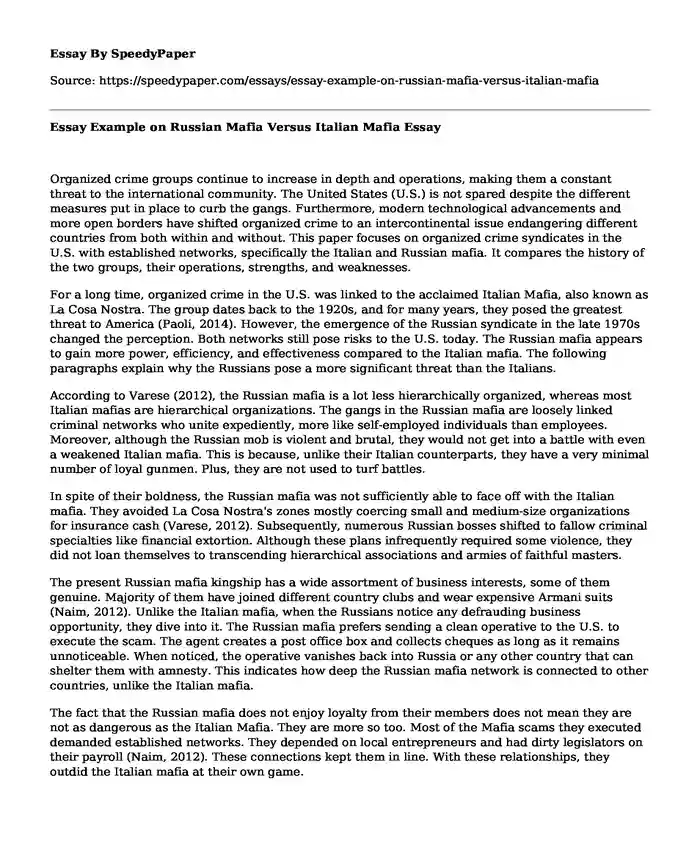
| Type of paper: | Essay |
| Categories: | Criminal law World |
| Pages: | 3 |
| Wordcount: | 684 words |
Organized crime groups continue to increase in depth and operations, making them a constant threat to the international community. The United States (U.S.) is not spared despite the different measures put in place to curb the gangs. Furthermore, modern technological advancements and more open borders have shifted organized crime to an intercontinental issue endangering different countries from both within and without. This paper focuses on organized crime syndicates in the U.S. with established networks, specifically the Italian and Russian mafia. It compares the history of the two groups, their operations, strengths, and weaknesses.
For a long time, organized crime in the U.S. was linked to the acclaimed Italian Mafia, also known as La Cosa Nostra. The group dates back to the 1920s, and for many years, they posed the greatest threat to America (Paoli, 2014). However, the emergence of the Russian syndicate in the late 1970s changed the perception. Both networks still pose risks to the U.S. today. The Russian mafia appears to gain more power, efficiency, and effectiveness compared to the Italian mafia. The following paragraphs explain why the Russians pose a more significant threat than the Italians.
According to Varese (2012), the Russian mafia is a lot less hierarchically organized, whereas most Italian mafias are hierarchical organizations. The gangs in the Russian mafia are loosely linked criminal networks who unite expediently, more like self-employed individuals than employees. Moreover, although the Russian mob is violent and brutal, they would not get into a battle with even a weakened Italian mafia. This is because, unlike their Italian counterparts, they have a very minimal number of loyal gunmen. Plus, they are not used to turf battles.
In spite of their boldness, the Russian mafia was not sufficiently able to face off with the Italian mafia. They avoided La Cosa Nostra's zones mostly coercing small and medium-size organizations for insurance cash (Varese, 2012). Subsequently, numerous Russian bosses shifted to fallow criminal specialties like financial extortion. Although these plans infrequently required some violence, they did not loan themselves to transcending hierarchical associations and armies of faithful masters.
The present Russian mafia kingship has a wide assortment of business interests, some of them genuine. Majority of them have joined different country clubs and wear expensive Armani suits (Naim, 2012). Unlike the Italian mafia, when the Russians notice any defrauding business opportunity, they dive into it. The Russian mafia prefers sending a clean operative to the U.S. to execute the scam. The agent creates a post office box and collects cheques as long as it remains unnoticeable. When noticed, the operative vanishes back into Russia or any other country that can shelter them with amnesty. This indicates how deep the Russian mafia network is connected to other countries, unlike the Italian mafia.
The fact that the Russian mafia does not enjoy loyalty from their members does not mean they are not as dangerous as the Italian Mafia. They are more so too. Most of the Mafia scams they executed demanded established networks. They depended on local entrepreneurs and had dirty legislators on their payroll (Naim, 2012). These connections kept them in line. With these relationships, they outdid the Italian mafia at their own game.
Conclusion
In conclusion, it is essential to note that organized criminal gangs are prevalent in the U.S. and that each group has its unique origin and modus operandi. The ills done by these groups cut crosswise over various segments of the economy. This makes their activities a significant concern. These gatherings cause impacts that are negative and even represent a risk to the whole American culture. Subsequently, fighting the gangs is, in this way, a crucial necessity.
References
Naim, M. (2012). Mafia states: Organized crime takes office. Foreign Aff., 91, 100. Retrieved from https://heinonline.org/HOL/LandingPage?handle=hein.journals/fora91&div=55&id=&page=
Paoli, L. (2014). The Italian Mafia. In The Oxford handbook of organized crime. Retrieved from https://www.oxfordhandbooks.com/abstract/10.1093/oxfordhb/9780199730445.001.0001/oxfordhb-9780199730445-e-025
Varese, F. (2012). The structure and the content of criminal connections: The Russian Mafia in Italy. European sociological review, 29(5), 899-909. Retrieved from https://academic.oup.com/esr/article-abstract/29/5/899/429198
Cite this page
Essay Example on Russian Mafia Versus Italian Mafia. (2023, Jan 26). Retrieved from https://speedypaper.net/essays/essay-example-on-russian-mafia-versus-italian-mafia
Request Removal
If you are the original author of this essay and no longer wish to have it published on the SpeedyPaper website, please click below to request its removal:
- Essay Example on Brand Equity
- Business Essay Sample: Yelp Analysis
- Oceanography Essay Example: The Blob
- Gymnastic Sexual Assault in US, Essay Example for Everyone
- Free Essay with a Case Study - Resume and Cover Letter
- Comparison Between the Handmaids Tale and Gattaca - Essay Example
- Review of Amazon's Information Management Systems, Free Essay Sample
Popular categories




